Past Events
Interested in Cotsen events? Sign up for our mailing list.In person with pizza
General introduction to the program and experimental archaeology with Dr. Wake demonstrating and teaching cordage making
Our first ever in person event
Contact
Phone
UCLA SNF Center for the Study of Hellenic Culture | Embassy of Greece in USA | UCLA Cotsen Institute of Archaeology | Archaeological Institute of America–LA County Society | present
Vassilis Lambrinoudakis
Professor Emeritus of Classical Archaeology
University of Athens
Register here
After registering, you will receive a confirmation email containing information about joining the meeting.
The unexpected finds during recent excavations in the sanctuary of Asclepius at Epidauros shed new light on the origins, cult, and function of Asclepius, the main Divine Healer of the Graeco-Roman world. An amazing ground-floor building that features α peristyle and basement hewn into the rock was excavated at the Tholos, the famous classical circular building with underground, meander-like passages. It defines the highly debated and mysterious function of the Tholos as the cult place of chthonic Asclepius, and explains his presence in Epidauros in the 7th century BC. A small portico, found under the later Abaton, preceded the latter as a primitive dormitory hall. It provides evidence for healing through incubation already in early archaic times. An ash altar and accommodations for ritual meals around it explains the parallel magic cure through the consumption of sacred food from the very beginning of the cult. The new finds enrich our knowledge of the sanctuary’s history and general healthcare in antiquity.
Her Excellency Alexandra Papadopoulou, Ambassador of Greece to the United States, will provide introductory remarks.
 Vassilis Lambrinoudakis is professor emeritus of the University of Athens; corresponding member of the Académie des Inscriptions et Belles-Lettres, Paris; and the Akademie der Wissenschaften, Vienna. He studied History and Archaeology at the Universities of Athens, Munich and Bonn. He is member of the German Archeological Institute and the Austrian Archaeological Institute. He excavates mainly in Epidauros/Argolid and the island of Naxos in the Aegean See. He also conducted excavations on the island of Chios, in Marathon/Attica and in Palaiomanina/Acarnania. He directs projects of enhancement of archaeological sites in Naxos and Epidauros. In 2003, he earned the first prize of Europa Nostra for the excavation and the enhancement of the sites Yria and Sangri/Naxos. He has published 14 books and monographs, as well as 186 papers on ancient Greek architecture and art, ancient topography, ancient Greek religion, epigraphy, theory of Archaeology, and management of monuments. He was co-editor of the Lexicon Iconographicum Mythologiae Classicae (LIMC I-VIII) and of the Thesaurus Cultus et Rituum Antiquorum (ThesCRA I-VIII). In 2003, he was honored by the President of the Hellenic Republic “for promoting the Archaeology and the History of Greece throughout the world.”
Vassilis Lambrinoudakis is professor emeritus of the University of Athens; corresponding member of the Académie des Inscriptions et Belles-Lettres, Paris; and the Akademie der Wissenschaften, Vienna. He studied History and Archaeology at the Universities of Athens, Munich and Bonn. He is member of the German Archeological Institute and the Austrian Archaeological Institute. He excavates mainly in Epidauros/Argolid and the island of Naxos in the Aegean See. He also conducted excavations on the island of Chios, in Marathon/Attica and in Palaiomanina/Acarnania. He directs projects of enhancement of archaeological sites in Naxos and Epidauros. In 2003, he earned the first prize of Europa Nostra for the excavation and the enhancement of the sites Yria and Sangri/Naxos. He has published 14 books and monographs, as well as 186 papers on ancient Greek architecture and art, ancient topography, ancient Greek religion, epigraphy, theory of Archaeology, and management of monuments. He was co-editor of the Lexicon Iconographicum Mythologiae Classicae (LIMC I-VIII) and of the Thesaurus Cultus et Rituum Antiquorum (ThesCRA I-VIII). In 2003, he was honored by the President of the Hellenic Republic “for promoting the Archaeology and the History of Greece throughout the world.”
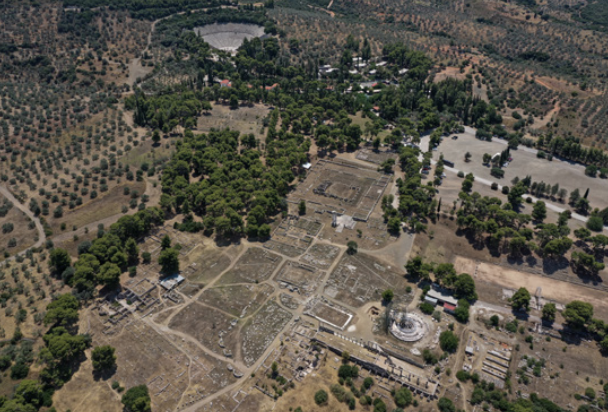

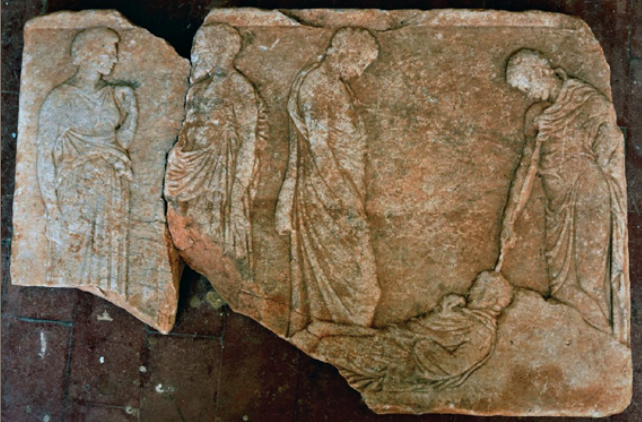
Contact Ellen Evaristo
Email eevaristo@humnet.ucla.edu
Phone
UCLA SNF Center for the Study of Hellenic Culture | UCLA Cotsen Institute of Archaeology | Archaeological Institute of America–Los Angeles County Society present
Dr. Anastassios C. Antonaras
Head of Exhibitions, Communication and Education Department
Museum of Byzantine Culture, Thessaloniki
Register here
After registering, you will receive a confirmation email containing information about joining the meeting.
This lecture examines the diverse population that lived in Byzantine Thessaloniki and the surrounding area through three case studies: a young girl with African religious beliefs who lived in the late 3rd century, a Slavic lady of the late 8th century, and a group of archers from the 14th - 15th century who were trained in the east. The first case study is a young girl who was buried in a simple pit tomb in the eastern necropolis of Thessaloniki. She wore two amulets: a wooden one, probably of ebony, in the shape of a male head with strong African features, and an amber one in the shape of feline bust. A Slavic lady, the second case study, is identified by a special bead that was found during excavations in the castle of Rentina, east of Thessaloniki. Such beads are characteristic of the Slavic tribes and similar examples have been found from the Volga region and Germany to Greece. A special type of men’s utilitarian jewelry, the ring of an archer, presents the third case study. This is a type of ring that initially had the sole purpose of protecting the thumb when the reflective bow’s string was released. These case studies demonstrate that among the population that lived in Byzantine Thessaloniki were a number of foreigners whose identity is only revealed through the careful examination of excavated objects.
Dr. Anastassios C. Antonaras, a specialist in the history of glass, jewelry and textiles, is an archaeologist and curator. He is Head of the Exhibitions, Communication and Education Department at the Museum of Byzantine Culture in Thessaloniki. His books include: Glassworking, Ancient and Medieval: Terminology, Technology and Typology (2008); Roman and Early Christian Glassworking: Vessels from Thessaloniki and Its Region (which received a prize from the Academy of Athens in 2010); Fire and Sand: Ancient Glass in the Princeton University Art Museum (2012); Artisanal Production in Ancient and Byzantine Thessaloniki: Archaeological, Literary and Epigraphic Evidence (2016; repr. 2019); Glassware and Glassworking in Thessaloniki: 1st Century BC – 6th Century AD (2017); and The Art of Glass. Works from the Collection of the Museum of Byzantine Culture (2019). He is currently researching different aspects of glass production and glassware in Byzantine and Ottoman Empire and publishing the rich and diverse, ancient and Islamic glass collection of the Getty Villa Museum.

Contact Ellen Evaristo
Email eevaristo@humnet.ucla.edu
Phone
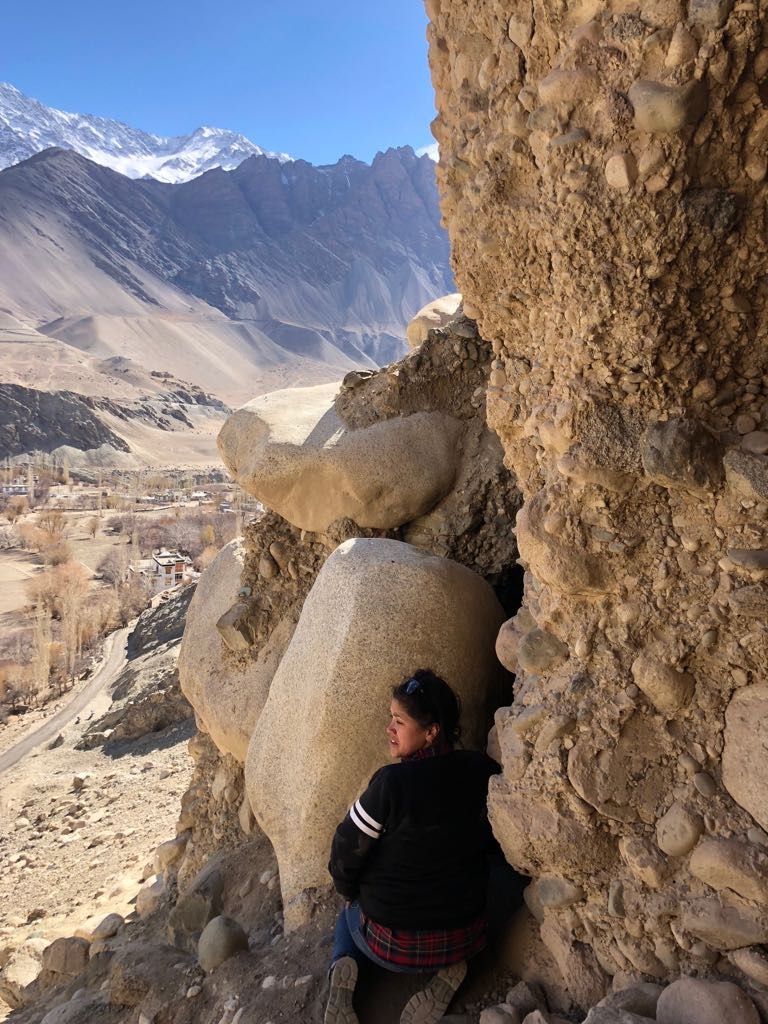 Ayesha Fuentes
Ayesha Fuentes
Stride Lecturer in Arts Conservation
Northumbria University
Ayesha Fuentes will discuss Tibetan and Himalayan religious use of ritual objects made with human skulls and femurs. Fuentes incorporates conservation methods, documentation, and interpretation of the material knowledge and techniques used to select, prepare, activate, maintain and exchange these objects. This project combines the technical examination of objects in museum collections with interviews and observations made across the Himalayan region and investigations of historical sources and cultural narratives. Her research highlights the longevity, function and value of these ritual instruments within diverse communities.
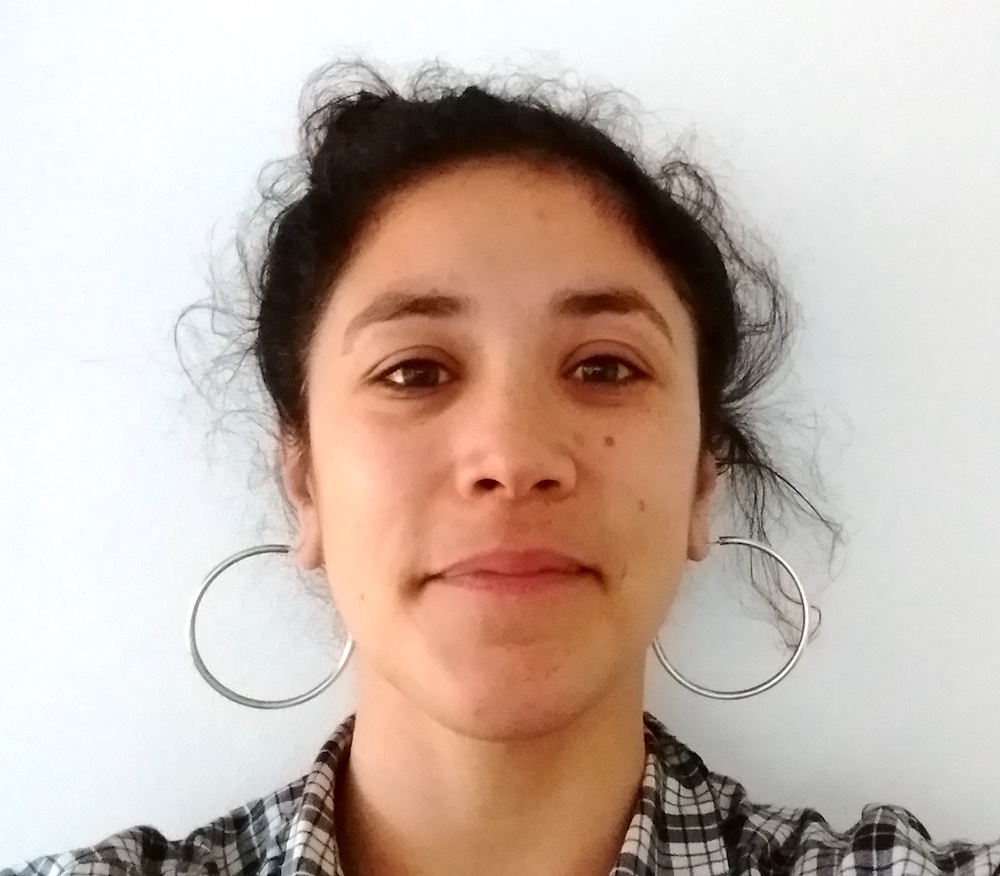 Ayesha Fuentes, Stride Lecturer in Arts Conservation at Northumbria University, is an objects conservator and technical art historian specializing in Asian material heritage. She is a graduate of the UCLA/Getty MA program in Conservation of Ethnographic Materials (2014) and a former employee at the Fowler Museum at UCLA. She recently submitted her doctoral dissertation on the use of human remains in Tibetan ritual objects at School of Oriental and African Studies (SOAS), University of London, where she was a Neil Kreitman and Overseas Research Scholar.
Ayesha Fuentes, Stride Lecturer in Arts Conservation at Northumbria University, is an objects conservator and technical art historian specializing in Asian material heritage. She is a graduate of the UCLA/Getty MA program in Conservation of Ethnographic Materials (2014) and a former employee at the Fowler Museum at UCLA. She recently submitted her doctoral dissertation on the use of human remains in Tibetan ritual objects at School of Oriental and African Studies (SOAS), University of London, where she was a Neil Kreitman and Overseas Research Scholar.
Contact Michelle Jacobson
Email mjacobson@ioa.ucla.edu
Phone
Jerry Moore
Department of Anthropology
California State University Dominguez Hills
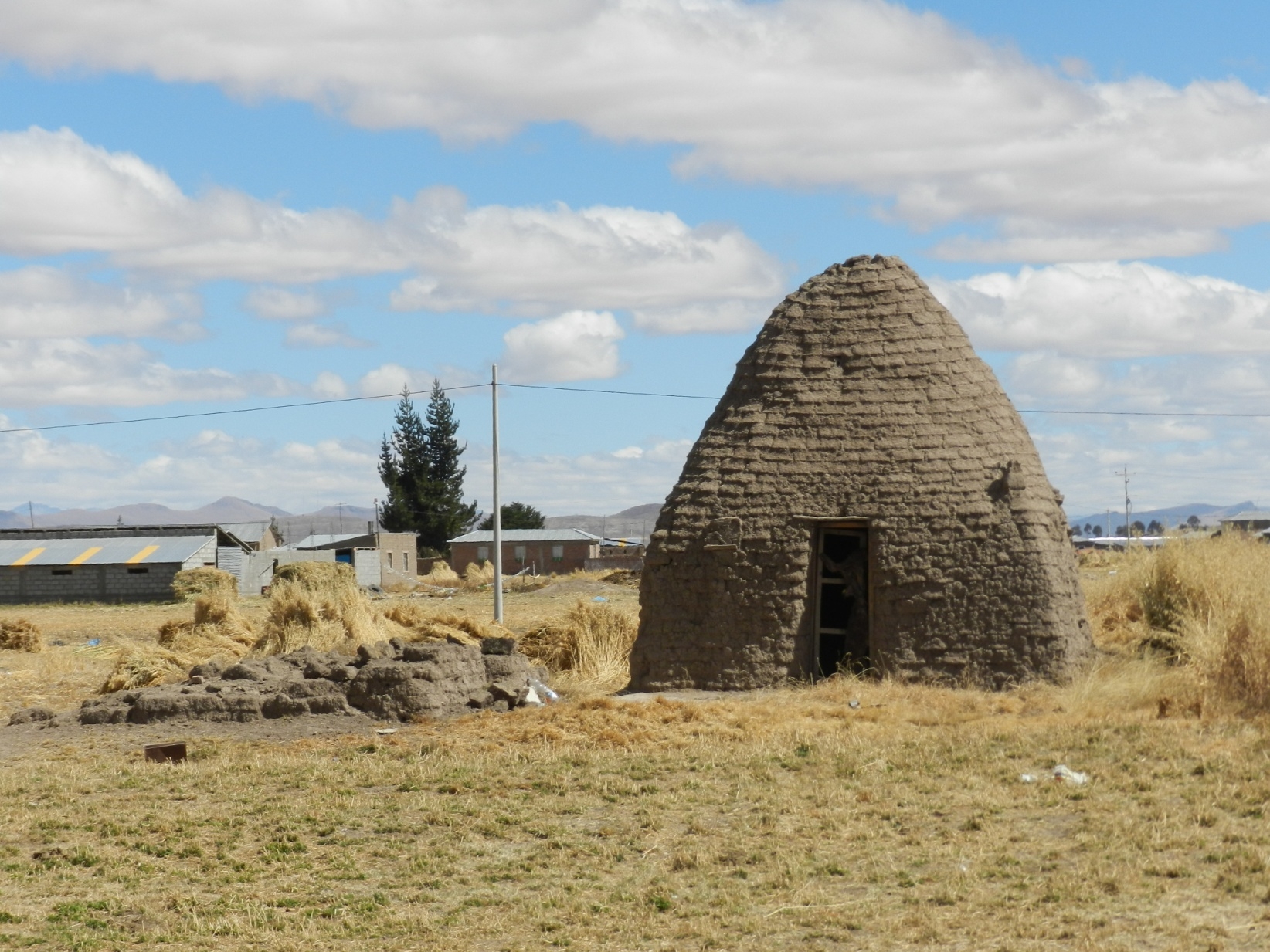
Moore's principal expertise is on the prehistoric architecture and cultural landscapes in the Andes. Archaeologists typically view architectural features of dwellings and other domestic architecture as built projects in which materials are modified according to a preconceived design in the builders’ minds. Although archaeologists usually acknowledge the different processes that transform buildings into archaeological features and sites, they tend not to understand how different buildings and construction methods inherently shape the archaeological record. This has direct implications for archaeological inferences about ancient households. Dr. Moore will discuss these issues referencing select case studies from Mesoamerica and the Andes.
Contact Michelle Jacobson
Email mjacobson@ioa.ucla.edu
Phone
Tessa de Alarcon, Grace Jan, Almoatz-bellah Elshahawi
Friday May 21st, 11:00am - 12:30pm (PT)
Tessa de Alarcon
How working in the US and Guatemala has Influenced the Way I Think About Conservation
 I will briefly discuss my experiences working in Guatemala as compared to working in the United States and reflect on how those experiences have impacted the way I work as a conservator. I am a Guatemalan American, I was born and raised in the US but have lived and worked in both the US and Guatemala. My introduction to conservation occurred in Guatemala and my first pre-program internship was there, as well. As a result, my introduction to best practices, ethics, and material evaluation all occurred in Guatemala. I then returned to the US for graduate school. Since obtaining my degree, I have worked on site in Guatemala and taught workshops there, in addition to working at the Penn Museum in Philadelphia as a project conservator. My exposure to different approaches, challenges, and issues in cultural heritage preservation has shaped me as a conservator. It has given me a unique perspective on decision making. In particular, I think it has helped me challenge assumptions and reflect on the way that a single problem can have many different possible solutions.This is not intended to be a formal presentation and will be very much based on my personal experiences and perspective.
I will briefly discuss my experiences working in Guatemala as compared to working in the United States and reflect on how those experiences have impacted the way I work as a conservator. I am a Guatemalan American, I was born and raised in the US but have lived and worked in both the US and Guatemala. My introduction to conservation occurred in Guatemala and my first pre-program internship was there, as well. As a result, my introduction to best practices, ethics, and material evaluation all occurred in Guatemala. I then returned to the US for graduate school. Since obtaining my degree, I have worked on site in Guatemala and taught workshops there, in addition to working at the Penn Museum in Philadelphia as a project conservator. My exposure to different approaches, challenges, and issues in cultural heritage preservation has shaped me as a conservator. It has given me a unique perspective on decision making. In particular, I think it has helped me challenge assumptions and reflect on the way that a single problem can have many different possible solutions.This is not intended to be a formal presentation and will be very much based on my personal experiences and perspective.
Tessa de Alarcon has been a project conservator at the Penn Museum in Philadelphia since 2012. She  was born and raised in the US but has lived and worked both in the US and Guatemala. Her introduction to conservation occurred while working as an intern at Casa Santo Domingo in Antigua,Guatemala. During her time at the Penn Museum she has worked on a variety of different projects including condition assessments, and gallery renovation projects. She has also worked as an archaeological field conservator.The bulk of her field work has been in Guatemala,but most recently she had the opportunity to work in Azerbaijan. She has also taught workshops on documentation and archaeological conservation at the Museo Nacional de Arqueología y Etnologíain Guatemala City.She received her MA from the UCLA/Getty Program in the Conservation ofArchaeological and Ethnographic Materials in 2012.
was born and raised in the US but has lived and worked both in the US and Guatemala. Her introduction to conservation occurred while working as an intern at Casa Santo Domingo in Antigua,Guatemala. During her time at the Penn Museum she has worked on a variety of different projects including condition assessments, and gallery renovation projects. She has also worked as an archaeological field conservator.The bulk of her field work has been in Guatemala,but most recently she had the opportunity to work in Azerbaijan. She has also taught workshops on documentation and archaeological conservation at the Museo Nacional de Arqueología y Etnologíain Guatemala City.She received her MA from the UCLA/Getty Program in the Conservation ofArchaeological and Ethnographic Materials in 2012.
Grace Jan
The Cross-cultural Evolution of Chinese Painting Conservation
 Freer Gallery of Art and Arthur M. Sackler Gallery, the Smithsonian's National Museum of Asian Art
Freer Gallery of Art and Arthur M. Sackler Gallery, the Smithsonian's National Museum of Asian Art
My ten-year career in Chinese painting conservation has provided cross-cultural experiences and insights into this evolving field. This talk will discuss this evolution in Chinese painting conservation education and training, culturalinitiatives, and techniques.
Chinese painting conservation requires specialized skills that were traditionally passed down through apprenticeship training. But over the last twenty years, significant changes to access and knowledge of Chinese painting conservation haveled toprogress and challenges in the field, impacting its practice domestically and within China.
This evolution is reflected in U.S. initiatives by the Freer Gallery of Art and Arthur M. Sackler Gallery, the Smithsonian's National Museum of Asian Art,and theAndrew W. Mellon Foundation. In 2000, the Freer and Sackler established the Chinese Painting Conservation Program, an initiative to train young professionals and develop cooperative projects promoting the care of Chinese paintings.In 2012, the Mellon Foundation furthered support of trainingand exchanges among conservators, and helped to endow a Chinese painting conservation position and fellowship program. These efforts helped establish a training pipeline of conservators.
Smithsonian's National Museum of Asian Art,and theAndrew W. Mellon Foundation. In 2000, the Freer and Sackler established the Chinese Painting Conservation Program, an initiative to train young professionals and develop cooperative projects promoting the care of Chinese paintings.In 2012, the Mellon Foundation furthered support of trainingand exchanges among conservators, and helped to endow a Chinese painting conservation position and fellowship program. These efforts helped establish a training pipeline of conservators.
Concurrently in China, I have observed a shift in training, from a traditional apprenticeship model to formalized degree programs. This has occurred alongside a nationwide prioritization of Chinese culture and heritage resulting in new museums and state-of-the-art conservation facilities. In addition, conservators have increased exposure to the diversity of conservation approaches across different regions of China.

My cross-cultural career has provided perspective on how the field could integrate Western and Chinesemethods. Shortened formalized training could be integrated with the apprenticeship model, ensuring the sustainability of Chinese traditional conservation. Implicit in all this is the merging of these cultures. In response, domestic and international collaboration and networks are crucial to advancing the field and leveraging knowledge and resources across the field.
 Grace Jan is the Yao Wenqing Chinese Painting Conservator at the Freer Gallery of Art and Arthur M. Sackler Gallery, the Smithsonian’s National Museum of Asian Art. Since 2009, she has worked on the museum’s Chinese painting and calligraphy collection and supported the museum’s Chinese Painting Conservation Program to promote domestic and international exchange and collaboration. She is active in facilitating the Andrew W. Mellon supported initiative to develop and promote this specialization across the U.S. Ms. Jan received anMAin Art History and Advanced Certificate in Conservation from the Institute of Fine Arts Conservation Center, New York University. Shetrained at the Shanghai Museum, Beijing Palace Museum, Metropolitan Museum of Art and the Museum of Fine Arts, Boston.
Grace Jan is the Yao Wenqing Chinese Painting Conservator at the Freer Gallery of Art and Arthur M. Sackler Gallery, the Smithsonian’s National Museum of Asian Art. Since 2009, she has worked on the museum’s Chinese painting and calligraphy collection and supported the museum’s Chinese Painting Conservation Program to promote domestic and international exchange and collaboration. She is active in facilitating the Andrew W. Mellon supported initiative to develop and promote this specialization across the U.S. Ms. Jan received anMAin Art History and Advanced Certificate in Conservation from the Institute of Fine Arts Conservation Center, New York University. Shetrained at the Shanghai Museum, Beijing Palace Museum, Metropolitan Museum of Art and the Museum of Fine Arts, Boston.
Almoatz-bellah Elshahawi
An Ancient Egyptian Ptolemaic Coinage: History and Preservation Methods
Ancient coins are one of the most important sources of information from which archaeologists and 
 Almoatzbellah Elshahawi a PhD candidate in the conservation at Cairo University, specializing in ancient Egyptian works on Metals and Coins. He is a graduatedintern at the J. Paul Getty Museum for one year(2019-2020). For the dissertation, he is researching on the evaluation of the efficiency of environmental inhibitors with Nano-reinforcement for the protection of archaeological bronze. He received a Master’s degree in Conservation, Cairo University, 2017. AlmoatzbellahElshahawi was a 2013-2017 Cairo university Fellow. A 2005-2009 Abou-Qir high conservation institute Fellow and most recently, an objectconservator at the Grand Egyptian Museum-Conservation Center (GEM-CC).
Almoatzbellah Elshahawi a PhD candidate in the conservation at Cairo University, specializing in ancient Egyptian works on Metals and Coins. He is a graduatedintern at the J. Paul Getty Museum for one year(2019-2020). For the dissertation, he is researching on the evaluation of the efficiency of environmental inhibitors with Nano-reinforcement for the protection of archaeological bronze. He received a Master’s degree in Conservation, Cairo University, 2017. AlmoatzbellahElshahawi was a 2013-2017 Cairo university Fellow. A 2005-2009 Abou-Qir high conservation institute Fellow and most recently, an objectconservator at the Grand Egyptian Museum-Conservation Center (GEM-CC).
Contact Jennifer McGough
Email jenmcgough@g.ucla.edu
Phone
Helina Woldekiros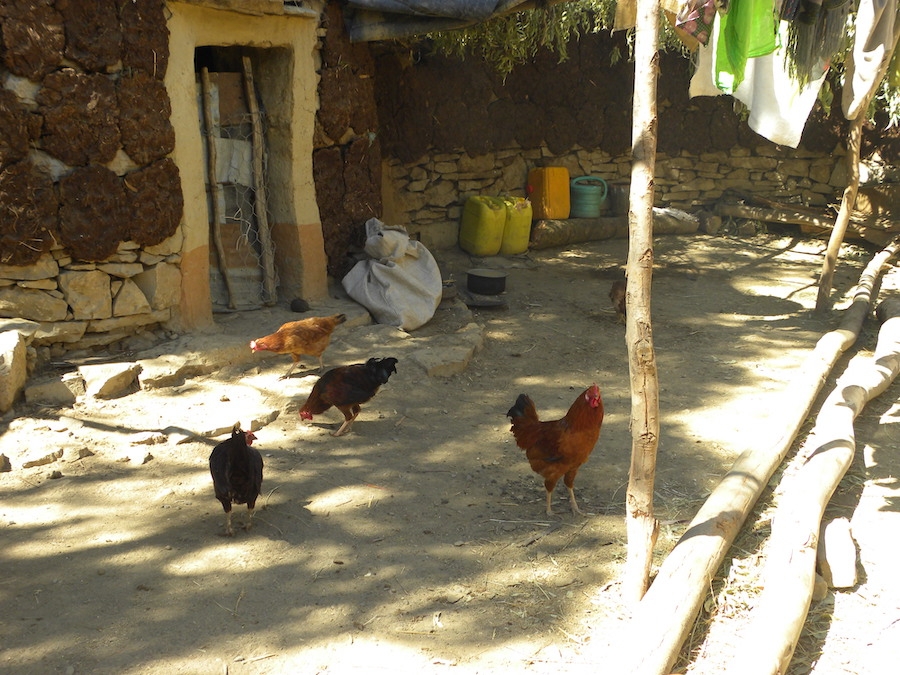
Assistant Professor, Department of Anthropology
Washington University
Domestic chickens (Gallus gallus domesticus L. 1758) are one of the most valued farm animals in the world today. Chickens are economically and socially significant in Africa. They are often associated with cuisine and identity as well as their ability to generate income for poor rural communities. Despite their importance, little is known about the nature of their introduction and subsequent integration into African economies. In this paper I present archaeological and biometric perspective on the introduction and development of chicken landraces in the Horn of Africa.
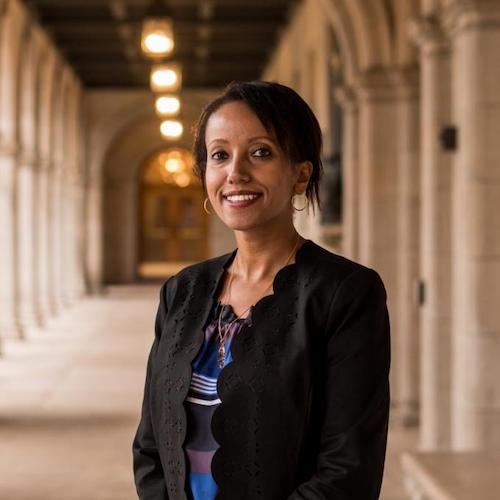 Dr. Helina Woldekiros is an assistant professor at the Department of Anthropology at Washington University in St. Louis. Woldekiros completed her Ph.D. at Washington University in St. Louis and her MA at the University of Florida. After completing a postdoctoral research at Ludwig Maximilian University in Munich, Germany, Woldekiros joined the Department of Anthropology at WU in 2015.Woldekiros's research interest includes state formation, the origin of food production, agriculture, pastoralism, salt trade, caravan archaeology, and livestock biodiversity in the Horn of Africa. Her upcoming book entitled "The Boundaries of Ancient Trade" re-conceptualizes state formation in the Horn Africa by looking at not only hierarchical political models but also heterarchical political models. She is also an expert in the domestication and spread of chickens globally.
Dr. Helina Woldekiros is an assistant professor at the Department of Anthropology at Washington University in St. Louis. Woldekiros completed her Ph.D. at Washington University in St. Louis and her MA at the University of Florida. After completing a postdoctoral research at Ludwig Maximilian University in Munich, Germany, Woldekiros joined the Department of Anthropology at WU in 2015.Woldekiros's research interest includes state formation, the origin of food production, agriculture, pastoralism, salt trade, caravan archaeology, and livestock biodiversity in the Horn of Africa. Her upcoming book entitled "The Boundaries of Ancient Trade" re-conceptualizes state formation in the Horn Africa by looking at not only hierarchical political models but also heterarchical political models. She is also an expert in the domestication and spread of chickens globally.
Contact Michelle Jacobson
Email mjacobson@ioa.ucla.edu
Phone
A conversation between Bárbaro Martínez-Ruiz and José Bedia,
Moderated by Manuel Jordán
May 18th, 10am - 11am PST
This program follows an exciting interdisciplinary seminar on African Objects in Museums, where students examined a series of objects including painted Yoruba drums and Kongo minkisi. To continue discussions, the Fowler Museum, the Cotsen Institute of Archaeology, the UCLA/Getty Conservation Program, UCLA Information Studies, and the UCLA Africa Studies Center are hosting a program where we will engage three specialists who are artists, scholars, and/or practitioners. The two speakers are members of the Afro-Cuban and Cuban diaspora, respectively.
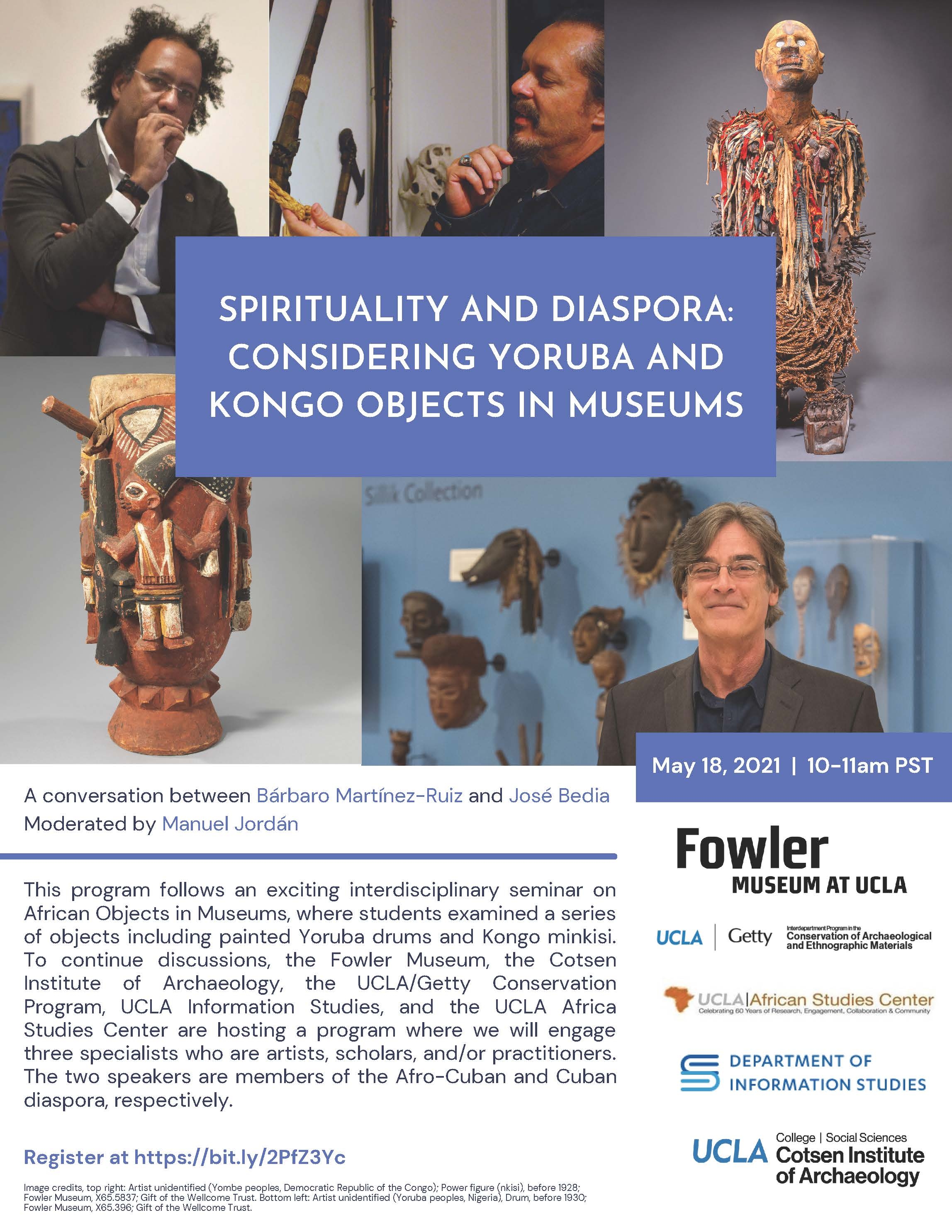
Contact Ellen Pearlstein
Email epearl@ucla.edu
Phone
Nathan Acebo, MA, PhD
University of California, Chancellor's Postdoctoral Scholar and Critical Mission Studies Postdoctoral Scholar
Anthropology & Heritage Studies
University of California, Merced
The study of the written history of Indigenous communities continues to evolve following new contributions from collaboration-based research partnerships committed to practicing Indigenous Archaeology. As a form of archaeology practiced with, by, and for Indigenous peoples, Indigenous Archaeology is reshaping our understanding of North American colonization by providing new perspectives on the vibrancy of Indigenous cultures and enduring political traditions. This talk showcases how Indigenous Archaeology was practiced in partnership with Tongva, Acjachemen and Payómkawichum communities in southern California to illuminate forms of political and economic autonomy beyond the reach of Spanish and Californio colonial authorities in the southern Los Angeles Basin hinterlands (1770-1848 CE). I present how the Black Star Canyon Archaeology Project’s (BSCAP: 2013-2021) analyses of orphan collections were specifically guided by Indigenous collaborators’ concept of “thrivance”—a condition of existence focused on political and economic dimensions of Indigenous autonomy—to yield said history and use archaeology as a tool for Indigenous storytelling on said peoples’ terms.
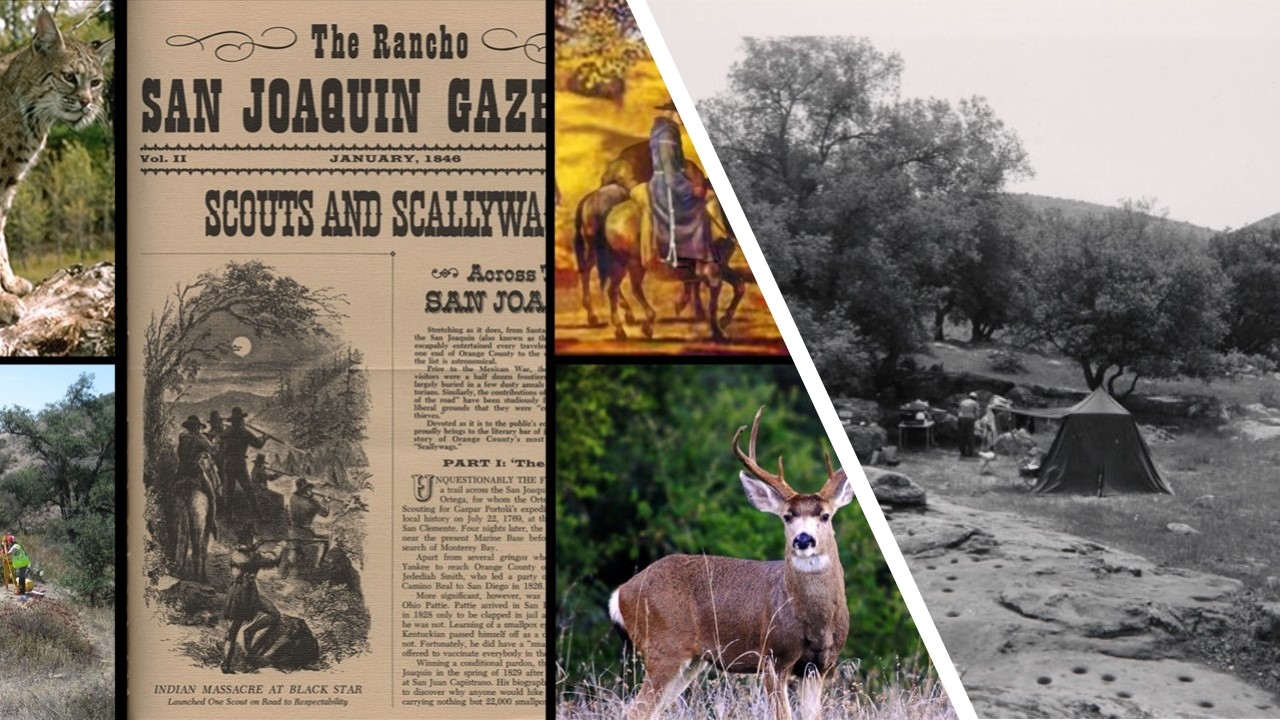
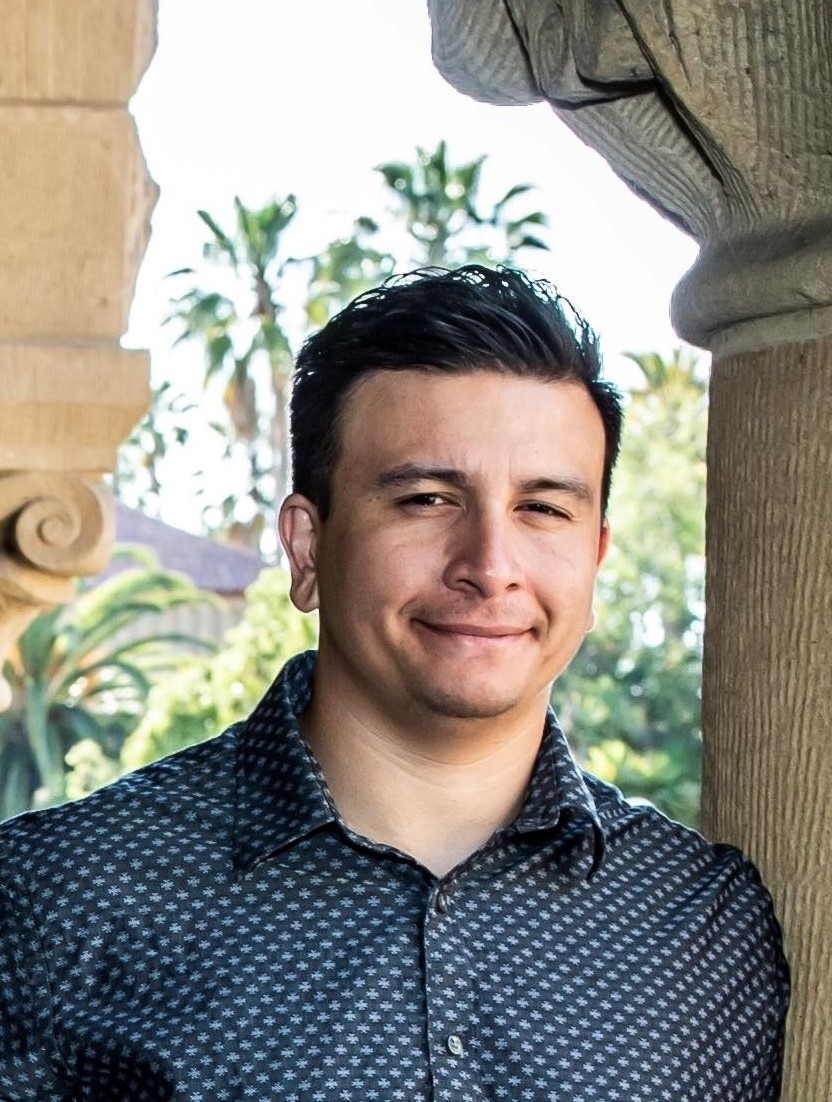 Dr. Nathan Acebo is the University of California Chancellor’s Postdoctoral Fellow in Critical Mission Studies for the 2020–2021 year at the University California, Merced and holds the position of Assistant Professor of Anthropology-Native American and Indigenous Studies at University of Connecticut beginning in August 2021. Dr. Acebo received his Ph.D. at Stanford University and was a fellow in the Enhancing Diversity in Graduate Education Doctoral Program (EDGE: 2013-2020), Institute for Research in the Social Sciences (IRiSS: 2019-2020), and Mellon Humanities Program (2019-2020). His research in southern California and Hawaii focuses on Indigenous networks, subaltern resistance, and decolonizing practices.
Dr. Nathan Acebo is the University of California Chancellor’s Postdoctoral Fellow in Critical Mission Studies for the 2020–2021 year at the University California, Merced and holds the position of Assistant Professor of Anthropology-Native American and Indigenous Studies at University of Connecticut beginning in August 2021. Dr. Acebo received his Ph.D. at Stanford University and was a fellow in the Enhancing Diversity in Graduate Education Doctoral Program (EDGE: 2013-2020), Institute for Research in the Social Sciences (IRiSS: 2019-2020), and Mellon Humanities Program (2019-2020). His research in southern California and Hawaii focuses on Indigenous networks, subaltern resistance, and decolonizing practices.
Contact Michelle Jacobson
Email mjacobson@ioa.ucla.edu
Phone
Bryan Kraemer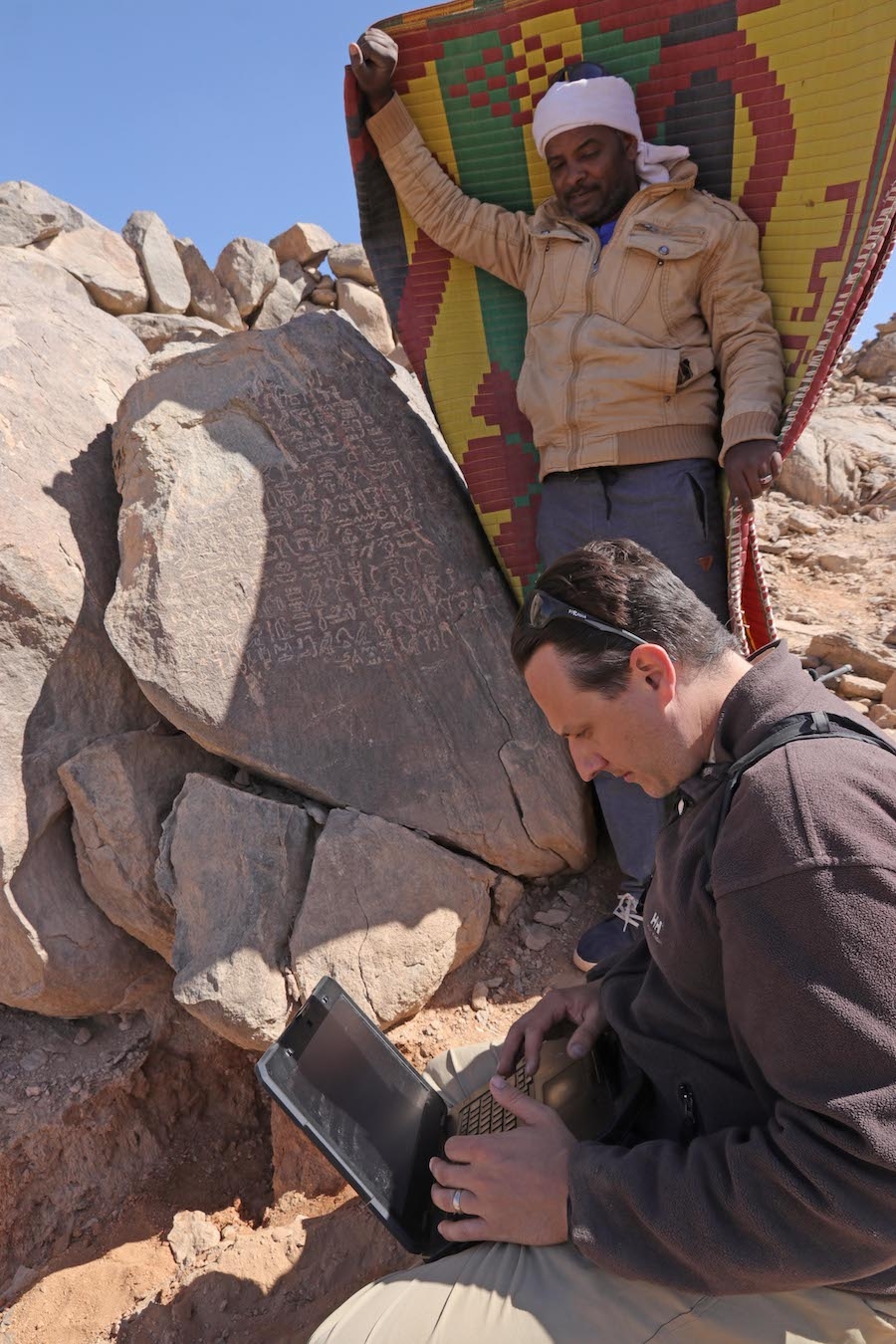
Egyptologist at the Robert and Frances Fullerton Museum of Art
California State University, San Bernardino
Since 2014, the Wadi el-Hudi Expedition has been surveying archaeological sites in Egypt’s Eastern Desert connected with ancient amethyst and gold mines. The ancient activity was concentrated in two periods, Egypt’s Middle Kingdom (circa 2000 -1700 BCE), and the Early Roman Period (late 1st century BCE to 2nd century CE). During the first period, the ancient miners, guardians, and administrators left an abundant epigraphic record of their activities. To date, 270 separate inscriptions have been recorded at Wadi el-Hudi. These show a wide range of formality in inscriptional technique between carefully crafted monumental stelae with long hieroglyphic texts on one hand to rock-pecked petroglyphs on the other. Partially published by Ahmed Fakhry in 1952 and Ahmed Sadek in 1980-85, the inscriptions of Wadi el-Hudi have contributed significantly to our understanding of how ancient Egyptian desert mining expeditions operated. The Wadi el-Hudi Expedition has now for the first time recorded these inscriptions within their archaeological context using a photogrammetry-based epigraphic methodology. This record is fully integrated into the 3-dimensional survey of the entire Wadi el-Hudi topography and archaeological remains. It therefore allows us not only to record but also to present the inscriptions in a digital reproduction of their original context. This detailed 3D record is especially important since modern gold mining threatens the existence of archaeological sites in this remote area of the desert.
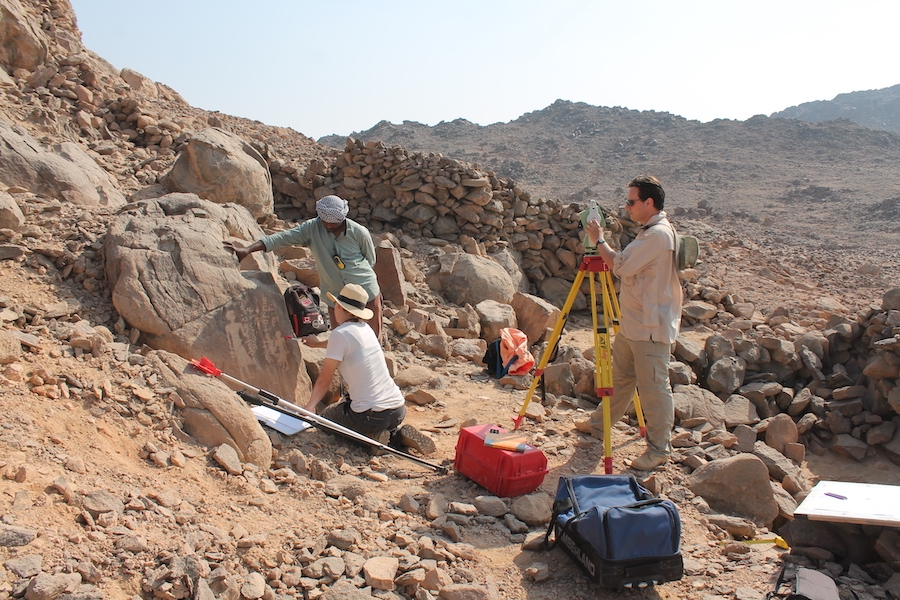
In this talk, I will present a selection of the current results of the Wadi el-Hudi Expedition’s epigraphic and archaeological survey. Taking from interpretive theories of Geosemiotics, I will present case studies from the results of the epigraphic working understanding how the inscriptions at Wadi el-Hudi were embedded in a nexus of social and linguistic actions that contributed to their meaning and defined the local versions of what one might call an epigraphic habit. Additionally, I will outline how we have incorporated 3D capture into every aspect of recording at Wadi el-Hudi and show the results and challenges of using this methodology.
The Wadi el-Hudi Expedition works under the auspices of California State University, San Bernardino and in compliance with the Ministry of Antiquities in Egypt. The expedition has conducted fiveseasons since 2014from which Iwill draw these results.
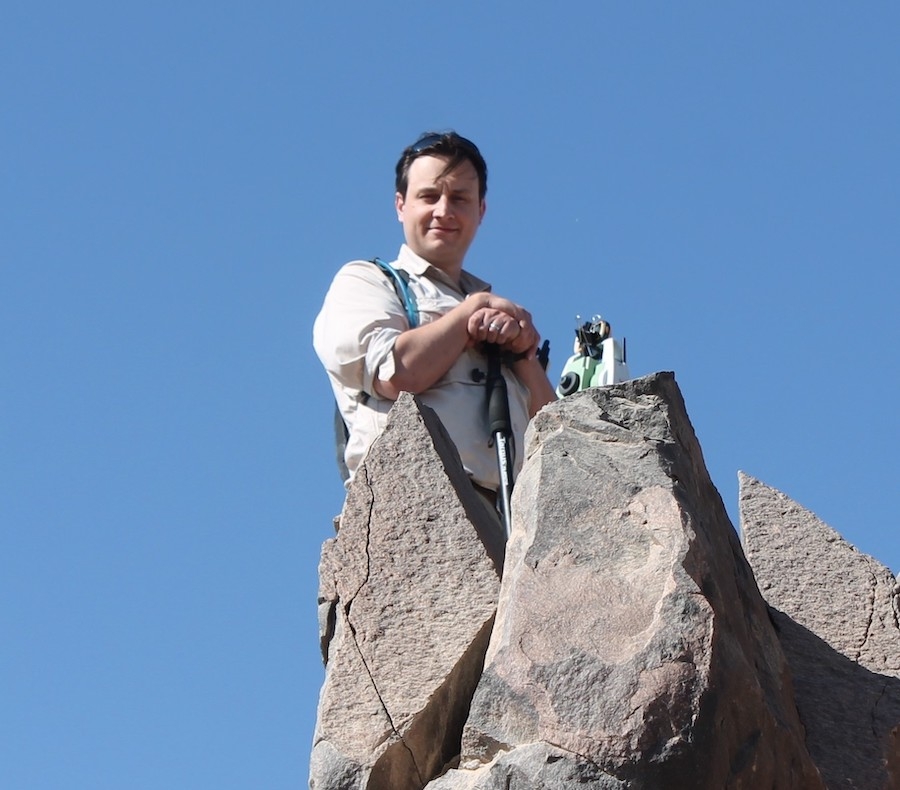 Bryan Kraemer is an Egyptologist at the Robert and Frances Fullerton Museum of Art (California State University, San Bernardino -CSUSB),where he is in charge of developing content related to the museum’s collections of artifact’s from Ancient Egypt. He is also a lecturer in the History Department at CSUSB. Bryanhas a Masters in Egyptology from the University of Chicago and a Masters in Archaeological Computing from Southampton University. He is also working on finishing his Ph.D. in Egyptology at the University of Chicago. Bryan’s research interests are in Ancient Egyptian religion and ritual, Ancient Egypt and the Classical World, Ancient Egyptian language, art, and archaeology, digital humanities, GIS, and digital frontiers in museums. He has worked and studied in Egypt over the last twenty years and taught Ancient Egyptian language and archaeology at University of Chicago, Princeton University, and California State University, San Bernardino. Bryan is currently working on a monograph on his work with the festival of Osiris at Abydos and a 3D archaeological atlas of maps from his work as co-director of the Wadi el-Hudi Expedition (www.wadielhudi.com).
Bryan Kraemer is an Egyptologist at the Robert and Frances Fullerton Museum of Art (California State University, San Bernardino -CSUSB),where he is in charge of developing content related to the museum’s collections of artifact’s from Ancient Egypt. He is also a lecturer in the History Department at CSUSB. Bryanhas a Masters in Egyptology from the University of Chicago and a Masters in Archaeological Computing from Southampton University. He is also working on finishing his Ph.D. in Egyptology at the University of Chicago. Bryan’s research interests are in Ancient Egyptian religion and ritual, Ancient Egypt and the Classical World, Ancient Egyptian language, art, and archaeology, digital humanities, GIS, and digital frontiers in museums. He has worked and studied in Egypt over the last twenty years and taught Ancient Egyptian language and archaeology at University of Chicago, Princeton University, and California State University, San Bernardino. Bryan is currently working on a monograph on his work with the festival of Osiris at Abydos and a 3D archaeological atlas of maps from his work as co-director of the Wadi el-Hudi Expedition (www.wadielhudi.com).
Contact Michelle Jacobson
Email mjacobson@ioa.ucla.edu
Phone
- ‹ previous
- 16 of 50
- next ›
